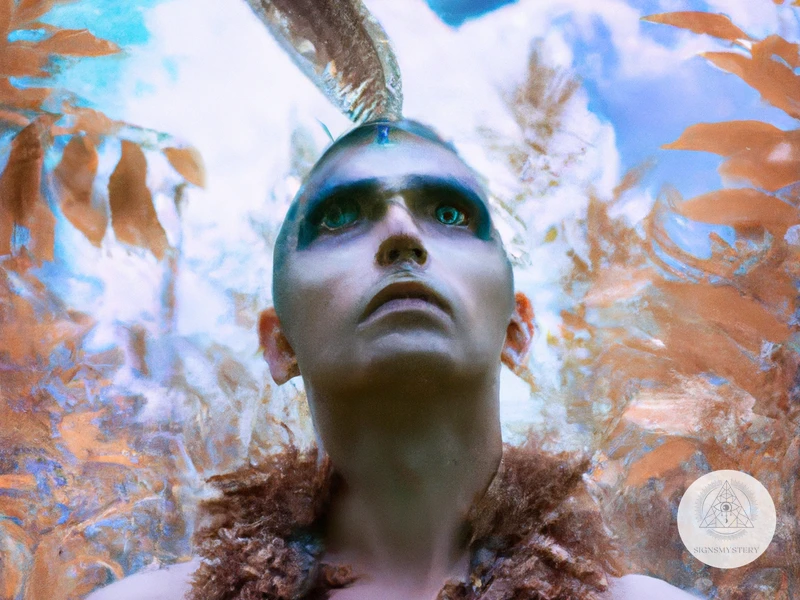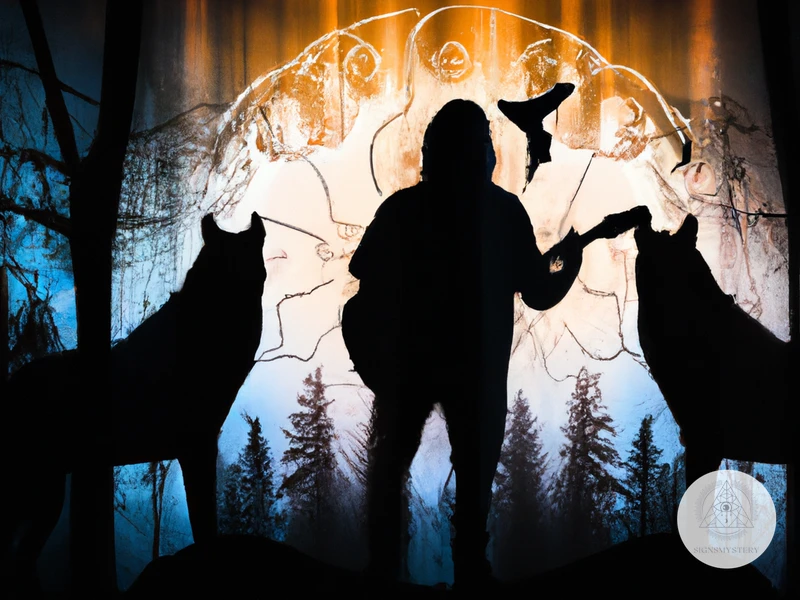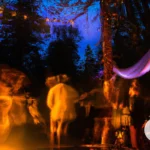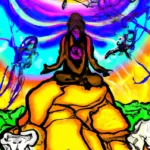Shamanism is a spiritual practice that has been around for centuries and is often associated with ancient cultures and tribes. However, over the years, shamanic themes have found their way into popular culture, from movies and TV shows to literature and music. As people continue to search for deeper connections to spirituality and the natural world, the popularity of shamanism in popular culture only seems to be growing. In this article, we will take a closer look at shamanism in popular culture, exploring its presence in movies and TV shows, literature, music, and even video games. Join us as we delve into this intriguing topic and uncover the many ways in which shamanic themes have impacted and influenced the media we consume.
Shamanism in Movies and TV Shows

Shamanism has been a popular theme in movies and TV shows for many years. From animated films like Disney’s “Brother Bear,” to horror movies like “The Witch,” shamanic themes have been incorporated into various genres. However, these depictions are often inaccurate and heavily influenced by cultural stereotypes. There are countless examples of shamanic cultural appropriation, where characters are portrayed as mystical, magic-wielding beings with no regard for the historical decline of shamanism in many indigenous communities. The portrayal of shamanism in popular culture has had a significant impact on the way society views and understands this spiritual practice.
Examples of Movies and TV Shows with Shamanic Themes
Shamanism has inspired many TV shows and movies. One example is “Avatar” directed by James Cameron, which features the Na’vi people and their connection to the natural world through a network of energy. The movie illustrates the idea of shamanism as a bridge between the human world and the spirit world.
Another example is the movie “The Serpent and the Rainbow,” based on the book by Wade Davis. The movie follows an ethnobotanist who travels to Haiti to investigate a drug that can turn people into zombies. The plot of the movie builds around Vodou, which is a religion that combines shamanism with African and Christian traditions.
There is a TV show called “American Gods” based on Neil Gaiman’s novel of the same name. The series merges elements of American mythology, ancient mythology, and modern pop culture. The show often presents shamanism in a more modern context, incorporating contemporary shamanistic practices into the storyline.
These are just a few examples of the many movies and TV shows that incorporate shamanic themes into their storyline. Shamanism has remained a characterising concept in popular culture, which highlights the human fascination with the spiritual realm.
New Age Shamanism Controversies and Contemporary vs Traditional Shamanism have also impacted the portrayal of shamanism in popular culture. Some argue that contemporary interest in shamanism is a watered-down version of what shamanism represents, while others believe that it is a natural evolution. Shamanism has become a significant influence on many aspects of contemporary culture, not just movies and TV shows.
Nonetheless, it’s important to remember that movies and TV shows often exaggerate and distort the realities of shamanism, and although they can be a fantastic source of entertainment, they don’t always provide an accurate portrayal of shamanic practices.
The Portrayal of Shamanism in Popular Culture
Shamanism has been a popular theme in movies and TV shows, literature, music, and video games. However, its portrayal in popular culture has often been a source of controversy. While some depictions have been somewhat accurate and respectful, others have been criticized for being culturally insensitive or perpetuating stereotypes about indigenous cultures.
One common stereotype is the portrayal of the shaman as a mystical figure who possesses magical powers and communicates with spirits. While these elements may be part of some indigenous practices, they don’t accurately reflect the diversity and complexity of shamanic traditions around the world.
On the other hand, some movies and TV shows have made an effort to portray shamanism in a more nuanced and respectful manner. For example, the movie Embrace of the Serpent (2015) portrays the relationship between a shaman and an anthropologist exploring the Amazon Rainforest in a thoughtful and sensitive way, highlighting the cultural differences and mutual respect between the two characters.
Similarly, the TV series Sense8 (2015-2018) features a character who is a practicing shaman and highlights the role of shamanism in different cultural contexts, including Korea, Iceland, and Mexico.
| Positive Portrayals | Negative Portrayals |
|---|---|
|
|
Indiana Jones and the Temple of Doom (1984) has been criticized for perpetuating stereotypes about Indian culture and shamanism, including the infamous scene with monkey brains and snake surprise. Similarly, Pocahontas (1995) has been criticized for its inaccurate and romanticized portrayal of the relationship between Native Americans and European settlers.
It’s important to note that shamanism is still practiced by indigenous communities around the world, and it should be respected as a living tradition rather than simply a source of inspiration for popular culture. One way to honor and appreciate shamanic practices is to learn about them from knowledgeable sources and support indigenous communities.
Shamanism is now recognized as a healing practice and is being integrated into therapy under the guidance of licensed therapists. This approach is called Shamanism Psychotherapy Alliance.
Shamanism in Literature
Shamanism has been a recurring theme in literature throughout history. The term shamanic literature refers to stories that feature shamanic practices, beliefs and rituals. Many cultures have their own version of shamanism and their stories reflect their unique cultural perspectives. In Native American literature, for example, one can find stories of shamans connecting with the spirits to heal the sick and guide the community. Some examples of shamanic literature are Carlos Castaneda’s “The Teachings of Don Juan” and Michael Harner’s “The Way of the Shaman”. These books explore shamanism’s role in indigenous cultures and its perceived benefits. Shamanic literature offers insight into mystical experiences and provides a window into the beliefs and practices of cultures that may otherwise be foreign to us.
Examples of Books with Shamanic Themes
There are numerous books that explore shamanic themes and practices from diverse cultures around the world. Below are some examples of books that showcase shamanism in literature:
| Book Title | Author | Description |
|---|---|---|
| The Teachings of Don Juan: A Yaqui Way of Knowledge | Carlos Castaneda | Based on the author’s experiences, this book documents his interactions with a Yaqui Indian shaman named Don Juan. The book explores the use of psychotropic plants and the teachings of shamanic practices. |
| Island of the Sun: Mastering the Inca Medicine Wheel | Alberto Villoldo | This book tells the story of the author’s journey to Peru to find healing in the ancient Incan traditions. The author learns about the Incan Medicine Wheel through his experiences on a journey to a place called the Island of the Sun where he finds a shaman who teaches him the ways of shamanic practices. |
| The Way of the Shaman | Michael Harner | Michael Harner is a respected anthropologist and shamanic practitioner who provides readers with practical instructions on shamanic practices that can be used for personal healing and spiritual growth. The book outlines the core foundation of shamanic practice from various cultures around the world. |
| The Eagle’s Gift | Carlos Castaneda | A spiritual guide who has come to take Castaneda through the final stages of his apprenticeship. Castaneda without a trace of the boyish eagerness that has been his trademark up to that point looks suspiciously at the nagual and for the first time doubts his own power. |
| The Four Insights: Wisdom, Power, and Grace of the Earthkeepers | Alberto Villoldo | This book is a compilation of the ancient shamanic practices of the Americas. The author describes four basic “insights” that are integral to shamanic practice. He also shares his own journey and how he came to know about the shamanic practice. |
”Note”: These books are just a glimpse of the shamanic literature available out there. With each book, you will enter into a new world of shamanic knowledge and practices that can help you to connect with yourself and with the universe.
The Evolution of Shamanic Literature
The evolution of shamanic literature is a fascinating subject that spans centuries. Throughout history, shamans have served as spiritual guides and healers in many cultures around the world. As a result, they have inspired countless works of literature across different genres and time-periods.
One of the earliest examples of shamanic literature is the epic poem “Gilgamesh,” which dates back to ancient Mesopotamia. The titular character seeks out a wise man named Utnapishtim, who is believed to have achieved immortality. Utnapishtim is essentially a shamanic figure, as he possesses knowledge of the divine that the hero Gilgamesh is seeking.
In more recent times, shamanism has been explored in a variety of literary genres, including fiction, non-fiction, and even poetry. For example, the novel “One Hundred Years of Solitude” by Gabriel Garcia Marquez explores shamanic themes through its use of magical realism. Similarly, the non-fiction book “The Serpent and the Rainbow” by Wade Davis documents the author’s experiences studying Haitian vodou and the practices of shamans in that culture.
Despite the varied approaches to shamanism in literature, there are certain motifs and themes that recur throughout different works. For example, shamanic literature often emphasizes the interconnectedness of all things, as well as the role of the shaman as mediator between the physical and spiritual realms. Additionally, many works of shamanic literature suggest that the shamanic journey is one of self-discovery and transformation.
The evolution of shamanic literature is a rich and complex subject that reflects the enduring appeal of shamanic practices and beliefs across different cultures and time-periods. From the earliest examples of epic poetry to modern-day works of magical realism, writers have sought to explore the shamanic experience in a variety of ways, resulting in a rich and diverse body of literature that continues to captivate readers today.
Shamanism in Music

Music has always been an important part of human culture, and it’s no surprise that shamanism has influenced it as well. The use of drums, rattles, and other percussion instruments in shamanic rituals has made its way into many different genres of music. From techno to folk, many musicians have drawn inspiration from shamanism for their lyrics and soundscapes. One example is the legendary rock band Led Zeppelin, whose song “Kashmir” features lyrics inspired by lyrics from the medieval Persian poet Hafiz and the band’s fascination with the mythology of the East. Another example is the Icelandic singer Björk, whose music is known for its ethereal quality and experimental sound. The influence of shamanism in music can be seen in both the lyrics and the sound, adding a mystical and otherworldly quality to the music that resonates with listeners. Whether it’s the use of chanting and tribal rhythms or the incorporation of natural sounds like birdsong or rainfall, shamanic elements can be heard in music across the globe.
Examples of Songs and Musicians with Shamanic Themes
Numerous musicians throughout history have drawn inspiration from shamanic cultures and integrated shamanic themes into their music. Indigenous cultures such as Native American, African, and South American have been the inspiration behind many of these songs.
One of the most popular examples of shamanic-inspired music is the album “Shaman” by Carlos Santana. The album features songs such as “Africa Bamba” and “Angel Love” that incorporate traditional Native American, African, and South American instruments such as drums, flutes, and shakers. The album’s aim is to create a trance-like experience that transports listeners to a spiritual realm.
Another example of a musician who incorporates shamanic themes into their music is Björk. Her album “Biophilia” features a song called “Thunderbolt” that is inspired by Inuit mythology. The song combines sounds of thunder and lightning with the story of thunder, making it a unique and powerful experience.
The Australian band “Dead Can Dance” has also incorporated shamanic themes into their music. Their song “The Host of Seraphim” is inspired by the story of The Red King in Aleister Crowley’s book “The Vision and the Voice”. The song begins with dark and haunting vocals, gradually building up to an intense and emotional experience.
Lastly, the band “Tool” has also been known to incorporate shamanism into their music. Their album “Lateralus” features a song called “Schism”, which is inspired by the shamanic concept of the shadow self. The song’s lyrics discuss the struggle between the light and dark sides of one’s psyche.
Musicians have drawn inspiration from shamanic cultures for centuries and integrated shamanic themes into their music. From Carlos Santana to Tool, shamanism has had a significant influence on the music industry, creating unique and spiritual experiences for listeners.
The Influence of Shamanism on Music
The influence of shamanism on music is undeniable. It has been a source of inspiration for many musicians across different genres. Shamanism, with its focus on spirituality, nature, and connection with the divine, has inspired musicians to create unique and mesmerizing sounds
Subscribe to Our Newsletter
Sign up to receive the latest news and updates.
One of the most significant ways shamanism has influenced music is through the use of traditional shamanic instruments. Musicians have used various traditional instruments such as drums, rattles, flutes, and bells in their compositions to create a shamanic atmosphere. For example, the Australian band Dead Can Dance is known for their use of traditional and exotic instruments in their music, including the didgeridoo and the shakuhachi.
Shamanism has also influenced the lyrics and themes in music. Many musicians have incorporated shamanic themes such as transcendence, spiritual awakening, and connection with nature in their lyrics. For instance, the American musician Carlos Santana has often spoken about how shamanism has influenced his music and his spiritual journey. He once said that his guitar “is a divining rod … a way of getting to know people, a way of absorbing something from them, a way of healing.”
Some musicians have even embraced shamanic practices in their performances. For example, the Icelandic singer Bjork has incorporated shamanic rituals in her performances, including the use of a throat singer and an Inuit drumming group.
Shamanism has had a profound influence on music, inspiring musicians to create unique sounds, incorporating shamanic themes in their lyrics and embracing shamanic practices in their performances. It is a testament to the universal appeal of shamanism and its enduring relevance in popular culture.
Shamanism in Video Games
Shamanism in video games has become a popular theme in recent years, adding an exciting and mystical element to gameplay. Examples of video games with shamanic themes include World of Warcraft, where players can interact with shamanic elements through various quests and in-game items, and Far Cry Primal, which takes place in a prehistoric setting where the protagonist uses shamanic abilities to survive. The role of shamanism in video games often involves the use of magic and spiritual powers, which adds an element of strategy to gameplay. Additionally, shamanic practices such as communicating with spirits or using herbs for healing may be incorporated into the game mechanics. The incorporation of shamanism in video games adds a unique and fascinating element to the gaming experience.
Examples of Video Games with Shamanic Themes
There are numerous video games that incorporate Shamanic themes into their gameplay and storytelling. Here are just a few examples:
| Game Title | Platform | Shamanic Elements |
|---|---|---|
| Far Cry Primal | PS4, Xbox One, PC | In this game, players take control of a hunter named Takkar during the Stone Age. Takkar’s tribe believes in and practices shamanism, and Takkar himself receives spiritual guidance and visions from a shaman named Tensay. |
| Never Alone (Kisima Ingitchuna) | PS4, Xbox One, PC, Switch | This puzzle-platformer is based on Inupiaq folklore and follows a young girl named Nuna and her Arctic fox companion. Throughout the game, Nuna interacts with various spirits and deities from Inupiaq mythology, who aid her on her journey. |
| World of Warcraft | PC | Shamans are a playable class in this massively multiplayer online role-playing game. Players can choose to create a character as a shaman, who can harness the power of the elements and communicate with spirits. |
| Assassin’s Creed III | PS3, Xbox 360, PC | This historical action-adventure game features a Native American protagonist named Connor, who is a member of the Kanien’kehá:ka tribe. Throughout the game, Connor receives guidance from a shaman named “the Spirit Woman.” |
| Okami | PS2, Wii, PS3 | In this action-adventure game, players control the Japanese sun goddess Amaterasu, who takes the form of a white wolf. Throughout the game, Amaterasu interacts with various Japanese deities and spirits, who provide her with powers and abilities. |
These are just a handful of examples of video games that incorporate Shamanic themes into their gameplay and storytelling. Each game offers a unique interpretation of shamanism, drawing from various cultural traditions and historical periods. Whether it’s harnessing the power of the elements, communicating with spirits, or interacting with various deities, these games offer players a chance to explore shamanic beliefs and practices in a new and exciting way.
The Role of Shamanism in Video Games
The role of shamanism in video games is quite diverse and intriguing. In most video games that feature shamanic themes, the shaman is usually portrayed as a wise, mystic figure that is either a playable character or an NPC (non-playable character) that guides the player on their journey. Some games that heavily feature shamanic themes and elements include World of Warcraft, Assassin’s Creed III, and Far Cry Primal.
In World of Warcraft, players can play as a shaman character class that utilizes the power of the elements to defeat their enemies. This includes the power of fire, earth, water, and air. The shaman class is known for their ability to heal, tank, or deal damage, making them a versatile character choice for players.
Assassin’s Creed III features a Native American protagonist named Connor, who is skilled in hunting and tracking. Throughout the game, Connor interacts with a shamanistic character named Kaniehtí:io, who provides guidance and knowledge about the natural world. Kaniehtí:io also teaches Connor how to use his “eagle sense,” which allows him to track his enemies using his keen senses.
Far Cry Primal takes players back in time to the prehistoric era, where they play as a shamanistic character named Takkar. Throughout the game, Takkar must navigate dangerous and unknown territory while relying on his shamanistic powers to defeat his enemies. This includes the power of animal spirits, which Takkar can call upon to aid him in battle.
The role of shamanism in video games is one that adds an interesting and mystical element to gameplay. Whether it’s through playable shaman character classes or the inclusion of shamanic NPCs, shamanism in video games can provide a unique and fulfilling gaming experience for players.
Conclusion
In conclusion, Shamanism has had a significant impact on popular culture, and it continues to do so. From movies and TV shows to literature, music, and even video games, Shamanism has become a common inspiration for creatives across different forms of art. It is intriguing to see the diverse ways in which Shamanism has been used in popular culture, from accurate depictions to more fictionalized versions.
It can be argued that the rise of Shamanism in popular culture reflects the growing interest in spirituality and more holistic approaches to health and well-being. Shamanism is an ancient practice that is rooted in an understanding of the interconnectedness of everything in the universe. Its teachings resonate with many people today, and thus its influence is felt in various mediums of popular culture.
As we continue to explore the ways in which Shamanism intersects with popular culture, we can undoubtedly expect to see more representations in different forms of art. While some of these representations may not be entirely accurate, they do serve to highlight the continued relevance of Shamanism as a source of inspiration and fascination. It is up to us to engage with these representations critically and interpret them with an open mind.
Overall, the influence of Shamanism in popular culture is a testament to the enduring power of this ancient practice. As we navigate an increasingly complex world, Shamanism offers a roadmap for understanding our place in the universe and living a more connected and fulfilling life. Its presence in popular culture serves as a constant reminder of the importance of embracing our spiritual selves and seeking out deeper meaning in our lives.
Frequently Asked Questions
1. What is shamanism?
Shamanism is a spiritual practice that involves communication with the spirit world through altered states of consciousness, often facilitated by trance-inducing techniques such as drumming, chanting, or the use of psychoactive substances.
2. What are some popular movies and TV shows with shamanic themes?
Some examples include “Avatar,” “10,000 BC,” “The Dark Crystal: Age of Resistance,” “The Shaman,” and “Apocalypto.”
3. How is shamanism depicted in popular culture?
Shamanism is often portrayed as a mystical and exotic practice used by indigenous people or ancient civilizations. It may also be associated with magic, healing, and other supernatural abilities.
4. What are some books with shamanic themes?
Some examples include “The Teachings of Don Juan: A Yaqui Way of Knowledge,” “The Way of the Shaman,” “The Red Book,” and “The Shaman’s Toolkit.”
5. What is the evolution of shamanic literature?
Shamanic literature has evolved over time, from early anthropological and ethnographic studies to contemporary works that blend spirituality, psychology, and self-help.
6. What are some songs and musicians with shamanic themes?
Some examples include “Shaman’s Blues” by The Doors, “Shaman” by Santana, “Shamanic Dream” by Anugama, and “Shamanic Journey” by Byron Metcalf.
7. How has shamanism influenced music?
Shamanism has influenced music through the use of traditional instruments like drums, rattles, and flutes, as well as the incorporation of indigenous rhythms and melodies into contemporary genres.
8. What are some video games with shamanic themes?
Some examples include “Far Cry Primal,” “Skyrim,” “World of Warcraft: Mists of Pandaria,” and “ShamanKing: Master of Spirits.”
9. What is the role of shamanism in video games?
Shamanism may serve as a thematic device in video games, providing a unique and mystical setting or adding a layer of spiritual depth to the game’s narrative or gameplay mechanics.
10. What is the significance of shamanism in popular culture?
Shamanism has become a popular cultural trope, representing an alternative spiritual path or a connection to nature and ancient wisdom. Its presence in media reflects a growing interest in exploring spiritual and mystical practices beyond established religions.










